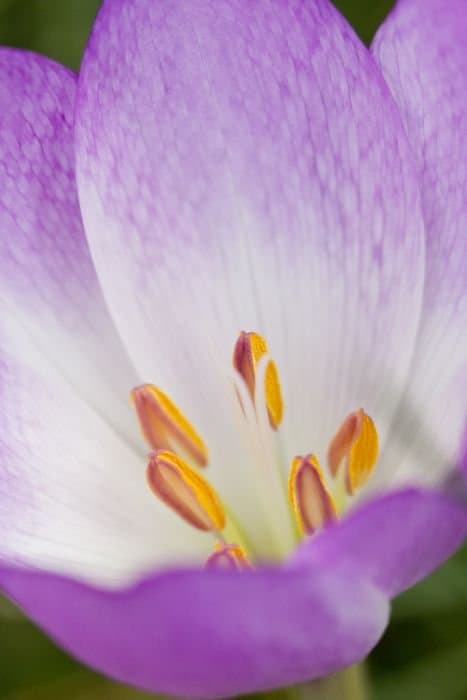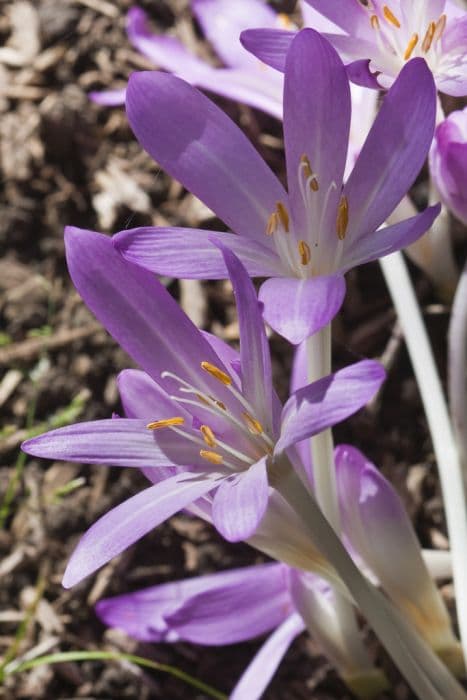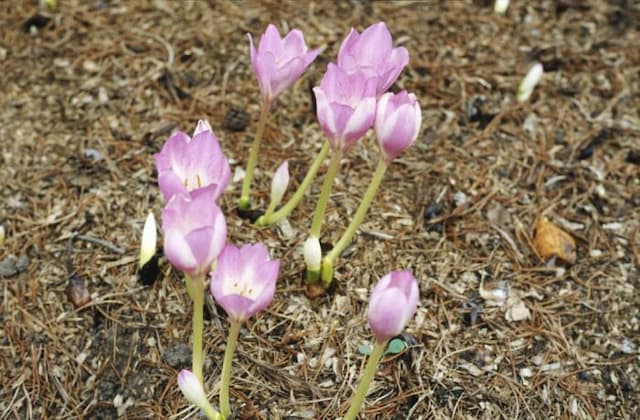Fairy Bells Disporum uniflorum

ABOUT
Disporum uniflorum, commonly referred to as fairy bells, is a herbaceous perennial beloved for its delicate aesthetic and woodland charm. This plant is adorned with bell-shaped flowers that hang daintily, usually appearing as a solitary bloom at the end of each stem. The color of these blooms is commonly a subtle yellowish-green, exuding a quaint simplicity. Supporting these flowers are slender stems that often have a gently arching quality, imbuing the plant with a soft, graceful appearance. The foliage of fairy bells consists of pointed, lance-shaped leaves that elegantly spiral up the stem, creating an artful, alternating pattern. The leaves are rich green, with lighter veins running through them, which adds to the depth and texture of the plant's overall look. In some instances, new leaves may unfurl at the tops of the stems, cradling the flower and adding an extra layer of greenery. While some plants are prized for their size, fairy bells is celebrated for the subtle understated beauty it brings to shaded garden areas. Its appearance can create a verdant backdrop or serve as an accent in a woodland-inspired garden composition. The modesty of its blooms and the lushness of its foliage make it a suitable companion for other shade-loving plants.
About this plant
 Names
NamesFamily
Colchicaceae.
Synonyms
Fairy Bell, Single-Flowered Fairy Bell.
Common names
Disporum smithii, Disporum pullum, Disporum hookeri, Disporum oreganum, Disporum trachyandrum, Prosartes hookeri, Prosartes smithii, Prosartes oregana, Uvularia sessilifolia, Uvularia sessilifolia var. smithii, Kuntheria trachyandra.
 Toxicity
ToxicityTo humans
Disporum uniflorum, commonly known as fairy bells, is not widely known for its toxicity to humans. However, as with many plants, it is generally advisable to avoid ingesting parts of plants that are not commonly recognized as food due to potential risks, which can range from mild gastrointestinal discomfort to more serious health issues. If fairy bells are ingested and an adverse reaction occurs, it would be prudent to consult a medical professional for advice and treatment.
To pets
Fairy bells are not widely recognized as being toxic to pets. However, as with any plant not typically included in a pet's diet, consumption of fairy bells could potentially lead to gastrointestinal upset, such as vomiting or diarrhea. If you suspect your pet has ingested parts of the fairy bells plant and is showing signs of distress, it is recommended that you consult a veterinarian for proper guidance and treatment.
 Characteristics
CharacteristicsLife cycle
Perennials
Foliage type
Deciduous
Color of leaves
Green
Flower color
White
Height
1-2 feet (0.3-0.6 meters)
Spread
1 feet (0.3 meters)
Plant type
Herb
Hardiness zones
5
Native area
Asia
Benefits
 General Benefits
General Benefits- Ornamental Value: Disporum uniflorum, commonly known as Fairy Bells, has an appealing aesthetic with delicate bell-shaped flowers and attractive foliage, making it a popular choice for shade gardens and woodland settings.
- Habitat Support: It can provide food and habitat for various species of insects and small animals, contributing to local biodiversity.
- Low Maintenance: Fairy Bells are known for being low maintenance, requiring minimal care once established, which can be beneficial for gardeners seeking easy-to-care-for plants.
- Shade Tolerance: This plant is particularly adept at growing in shaded areas where other plants might struggle, offering greenery in darker parts of the garden.
- Soil Enrichment: As part of its lifecycle, Fairy Bells contribute to the organic matter in the soil, enhancing soil quality over time through leaf and root decay.
- Erosion Control: The root system of Fairy Bells can help stabilize soil and control erosion in sloped or delicate areas of a landscape.
- Seasonal Interest: The plant adds seasonal interest with its spring flowers and sometimes colorful autumn foliage, providing visual interest throughout different seasons.
- Wildlife Friendly: It can attract pollinators such as bees and butterflies, which are essential for the pollination of many plants and the overall health of the ecosystem.
- Diversity: Adding Disporum uniflorum to a garden can increase plant diversity, which is generally beneficial for a robust and resilient plant community.
- Naturalizing: Fairy Bells are capable of spreading and naturalizing in an area, creating a more natural and self-sustaining environment over time.
 Medical Properties
Medical Properties- This plant is not used for medical purposes.
 Air-purifying Qualities
Air-purifying QualitiesThis plant is not specifically known for air purifying qualities.
 Other Uses
Other Uses- Fairy Garden Addition: Disporum uniflorum, commonly known as fairy bells, with its delicate bell-shaped flowers, is an enchanting plant suitable for creating whimsical fairy gardens.
- Natural Dye: The leaves and stems of the fairy bells can be used to extract a subtle green dye for coloring fabrics or yarn.
- Education and Research: Botanical researchers and students can study fairy bells to understand the ecology and reproductive biology of woodland plant species.
- Photographic Subject: The unique appearance of Disporum uniflorum makes it an interesting subject for photographers specializing in plant and nature photography.
- Culinary Garnish: The flowers can serve as a delicate garnish for culinary presentations, although they are not widely recognized as an edible garnish.
- Ground Cover: Fairy bells can be used as an attractive ground cover in shaded garden areas, providing a natural and low-maintenance carpet of green.
- Seasonal Indicator: The blooming period of fairy bells can act as a phenological indicator, signaling the start of spring in a given region.
- Artistic Inspiration: Artists may use the aesthetic of fairy bells as inspiration for various forms of art, including paintings, illustrations, and fabric designs.
- Theme Gardens: Disporum uniflorum can be incorporated into theme gardens that focus on folklore, due to the plant's common name and enchanting appearance.
- Container Planting: The slow growth and compact nature of fairy bells make it suitable for container planting, adding a touch of forest ambiance to balconies and patios.
Interesting Facts
 Feng Shui
Feng ShuiThe Fairy Bells is not used in Feng Shui practice.
 Zodiac Sign Compitability
Zodiac Sign CompitabilityThe Fairy Bells is not used in astrology practice.
 Plant Symbolism
Plant Symbolism- Mystery: Disporum uniflorum, also known as Fairy Bells, has a subtle and almost ethereal appearance, which often symbolizes the mystery and enchantment of the natural world.
- Elegance: The delicate structure and graceful droop of the Fairy Bells' flowers are often associated with elegance and refined beauty.
- Resilience: Despite its delicate appearance, Fairy Bells are hardy plants, symbolizing the ability to endure challenging conditions with grace.
- Ostentation: The pendulous, bell-shaped flowers and often-secluded nature of Disporum uniflorum can symbolize a quiet showiness or understated ostentation.
 Water
WaterFairy bells, the common name for Disporum uniflorum, prefer consistently moist soil, so you should water them deeply once a week, providing approximately one gallon of water per square yard of soil. During the growing season, in spring and summer, you may need to water twice a week if the weather is particularly dry or hot. In winter, reduce watering to every other week to prevent waterlogging. Be diligent about drainage as well; although fairy bells like moist soil, they can suffer from root rot if the soil is soggy.
 Light
LightFairy bells thrive in partial shade or dappled sunlight. They are best positioned in a spot that is protected from the harsh afternoon sun. Morning light, with protection from the strong midday rays, is ideal to promote healthy growth without scorching the leaves.
 Temperature
TemperatureFairy bells are cold-hardy plants that can tolerate temperatures down to about 10 degrees Fahrenheit. They grow best in temperatures ranging from 50 to 70 degrees Fahrenheit. While they can withstand brief periods of heat above this range, prolonged exposure to temperatures over 80 degrees Fahrenheit may stress the plant.
 Pruning
PruningFairy bells require minimal pruning, mainly to remove dead or damaged foliage and to maintain shape. The best time for pruning is in the late winter or early spring before new growth starts. They do not need to be pruned often; a light trim every few years is usually sufficient.
 Cleaning
CleaningAs needed
 Soil
SoilFairy Bells prefer humus-rich, well-draining soil with a pH between 5.5 and 7.0. A mix of loamy soil, peat, and perlite or pine bark can provide the necessary drainage and fertility.
 Repotting
RepottingFairy Bells should be repotted every 2 to 3 years to refresh the soil and accommodate root growth. It's best to repot in the spring just before the growing season.
 Humidity & Misting
Humidity & MistingFairy Bells thrive in moderate to high humidity levels, ideally between 60% and 80%. They can tolerate lower humidity but prefer consistent moisture in the air.
 Suitable locations
Suitable locationsIndoor
Place in well-lit area, avoid direct sunlight, keep soil moist.
Outdoor
Part shade to full shade, moist well-drained soil, protect from wind.
Hardiness zone
4-8 USDA.
 Life cycle
Life cycleDisporum uniflorum, commonly known as Fairy Bells, begins its life cycle with seed germination, occurring in damp, cool soil conditions, often in the shade of a forest. The seed develops into a young plant with a single shoot that emerges above the ground, bearing small, lance-shaped leaves. As the plant matures, it forms clumps with multiple stems, each bearing a single, nodding, bell-shaped flower at the top, which is typically white or greenish-white. After pollination, often by insects, the flower is followed by the development of a berry-like fruit containing seeds, which are subsequently dispersed by foraging animals or by gravity. The plant then enters a dormancy period in winter, where above-ground growth dies back and the plant conserves energy through its rhizomes. With the return of favorable conditions in spring, Fairy Bells resumes growth, completing its perennial life cycle.
 Propogation
PropogationPropogation time
Spring to Summer
Disporum uniflorum, commonly known as the Fairy Bells, benefits from propagation during its dormancy period in late fall to early spring. The most popular method of propagation for this plant is by division of its rhizomes. To propagate by division, carefully dig up the plant while trying to minimize root disturbance. Once unearthed, use a sharp knife or spade to gently separate the rhizomes into smaller sections, making sure that each section has at least one growth bud. Replant the divisions at the same depth they were growing previously, spacing them about 12 inches (approximately 30 centimeters) apart to allow sufficient room for growth. Water the newly planted divisions well to help establish them. This method is simple, effective, and often yields robust new plants that will mature into full clumps over the next few growing seasons.









